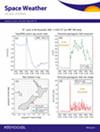Effects of Forbush Decreases on the Global Electric Circuit
IF 3.7
2区 地球科学
引用次数: 0
Abstract
The suppression of high-energy cosmic rays, known as Forbush decreases (FDs), represents a promising factor in influencing the global electric circuit (GEC) system. Researchers have delved into these effects by examining variations, often disruptive, of the potential gradient (PG) in ground-based measurements taken in fair weather regions. In this paper, we aim to investigate deviations observed in the diurnal curve of the PG, as compared to the mean values derived from fair weather conditions, during both mild and strong Forbush decreases. Unlike the traditional classification of FDs, which are based on ground level neutron monitor data, we classify FDs using measurements of the Alpha Magnetic Spectrometer (AMS-02) on the International Space Station. To conduct our analysis, we employ the superposed epoch method, focusing on PGs collected between January 2010 and December 2019 at a specific station situated at a low latitude and high altitude: the Complejo Astronómico El Leoncito (CASLEO) in Argentina (31.78°S, 2,550 m above sea level). Our findings reveal that for events associated with FDs having flux amplitude (A) decrease ≤10%, no significant change in the PG is observed. However, for FDs with A > 10%, a clear increase in the PG is seen. For these A > 10% events, we also find a good correlation between the variation of Dst and Kp indices and the variation of PG.福布什下降对全球电路的影响
高能宇宙射线的抑制,即福布什衰减(FDs),是影响全球电路(GEC)系统的一个有希望的因素。研究人员通过研究在天气晴朗地区进行的地基测量中电势梯度(PG)的变化(通常是破坏性的),对这些影响进行了深入研究。在本文中,我们旨在研究在轻微和强烈的福布什下降过程中,与根据晴朗天气条件得出的平均值相比,在电位梯度昼夜曲线上观察到的偏差。与传统的基于地面中子监测器数据的 FDs 分类不同,我们利用国际空间站阿尔法磁谱仪(AMS-02)的测量数据对 FDs 进行分类。为了进行分析,我们采用了叠加纪元法,重点关注 2010 年 1 月至 2019 年 12 月期间在阿根廷(31.78°S,海拔 2,550 米)低纬度、高海拔的特定站点:Complejo Astronómico El Leoncito (CASLEO)收集的 PGs。我们的研究结果表明,对于与通量振幅(A)下降≤10%的 FD 相关的事件,没有观测到 PG 的显著变化。然而,对于通量振幅(A)大于 10%的 FD,PG 有明显增加。对于这些 A > 10%的事件,我们还发现 Dst 和 Kp 指数的变化与 PG 的变化之间有很好的相关性。
本文章由计算机程序翻译,如有差异,请以英文原文为准。
求助全文
约1分钟内获得全文
求助全文

 求助内容:
求助内容: 应助结果提醒方式:
应助结果提醒方式:


